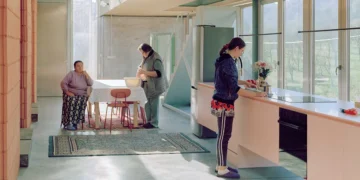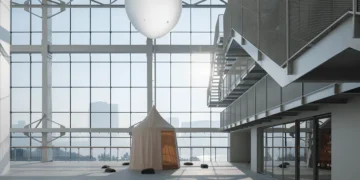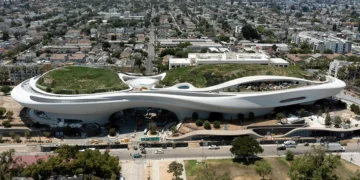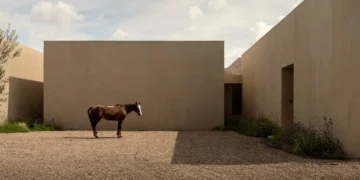
Set in the countryside near Gradačac, Bosnia and Herzegovina, the House for Five Women edefines communal living, offering a space of autonomy and resilience for women who have survived war, violence, and social injustice. Developed by TEN in collaboration with Engineers Without Borders, Vive Žene, and local organizations, the project provides a space where individuals can rebuild their lives through self-determination and mutual support.
ARCHITECTURE
The house was inspired by the personal journey of Hazima Smajlović and took seven years of collaboration to bring to life. Contributions from local metalworkers, carpenters, and craftspeople helped shape its distinctive architecture, making it a reflection of the community itself. The design process emphasized transparency, with resources carefully managed through annual reports and an accountable project committee.

Architecturally, the structure embraces adaptability. The 25-meter-long facade features 20 doors that open towards the landscape, blurring the line between indoors and outdoors. Residents have the freedom to personalize and inhabit the space as they see fit, creating an evolving household that respects both individual and collective needs. The design prioritizes raw space, allowing for continual transformation rather than rigid programming.
Key contributors such as landscape architect Daniel Ganz and artist Shirana Shahbazi further integrated the house into its surroundings. Ganz developed a food garden that supports agricultural self-sufficiency, while Shahbazi transformed the facade and interior with dynamic colors, applied in collaboration with local car painters. This fusion of practical and artistic elements results in a home that is both functional and expressive.

The upper floor houses a 26-meter-long multipurpose space inspired by traditional pastoral storage typologies. Clad in metal panels on the exterior and timber on the interior, it serves as a flexible area for seasonal activities, storage, or additional residency. This deliberate openness ensures the house remains responsive to the evolving needs of its inhabitants.
At its core, the House for Five Women challenges conventional notions of control and completion. Instead of imposing fixed solutions, it fosters a framework for continuous reinvention. Residents dictate their own length of stay and participate in shaping their shared environment, reinforcing a culture of collective responsibility. With the NGO Naš Izvor overseeing its maintenance, the house will continue to grow alongside its community, offering a living model of resilience, autonomy, and interconnectedness.

Visit our ArchiSCENE.net for more info.



















